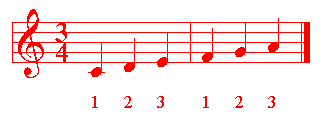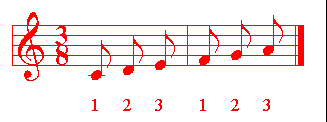Pandit Shiv Dayal Batish
Raga Manavati
Ashwin Batish and family Live
The UC Theater, Berkeley, California.
Meena Batish
Words by Ghalib
Music by S.D. Batish
Phone: (831) 423-1699

Western Staff Notation Part 1
by Ashwin Batish
In all our works at the Batish Institute, we stress educating yourself on the basics of Western staff notation. The reason is twofold. First, It is a great tool for disseminating musical information (and we can all benefit from that). Second, It makes our (Batish) musical works comprehensible by a large majority of Western musicians that have for many years been in the dark about Indian music. To see Indian music in a recognizable format has helped many of our students grapple with, and come to terms with raga compositions.
In this first article, I will try to give you an overview of this wonderful system of notation. In upcoming lessons, I will elaborate on the more complex areas of staff notation. But to learn Indian music via staff, you really need only a basic understanding, and this is really the goal of these articles in RagaNet. For anyone interested in becoming an expert in this field, I suggest you buy good primer on this subject. Also, take some lessons with a Western music teacher. Use your favorite Indian instrument or just a simple keyboard.
Ingredients
-
Keep things simple. I am going to list the basics for you. Then, with the help of midi files, I'll try and give you a microscopic view into the application of each staff element.
Staff notation is a musical map for you to follow. The elements you have to familiarise yourself with are as follows
Notes
Those little dots on horizontal lines. Here is an example of the basic note set
Rests
Vertical squigles placed on the staff. Here is what these look like. They follow the same time value as the notes above eg. whole, half, quarter, eighth, sixteenth, and thirty second.
Key signatures
This tells you which note is the tonic (Sa). Since we only plan to wirte in the key of C, I won't list the various key signature possibilities here. If you want to research this further, please buy a good primer on staff notation.Time signature
To tell you the rhythm the music is composed in. Here is what these can look like

The 3/8 Time signature means that there are 3 beats in each measure and each beat has the value of an eighth note.

THe 4/4 time signature means that there are 4 beats in each measure and each is given the value of a quarter note.
Note identifiers and modifiers
These tell you if a certain note is, or should be, considered a flat, sharp, or natural. Here is what they look like
Clefs
Treble, Bass, Alto, Tennor, and in some cases Percussion. Here is an image of these.
Movement symbols
These are symbols like repeats, Segno, Coda, 1st ending, 2nd ending etc. They tell you how to travel on the chart. Here are some commonly used symbols you should know aboutAccents
These are symbols that "humanize" the music. They can be thought of as "hints" and they will help you understand what the composer had in mind when the piece was created. Here is a collection of these
Please Note: All content is copyright ©2003 Ashwin
Batish. All rights reserved. Unauthorized copying, photocopying,
transmitting this document on hard paper or electronically or by any other
means is strictly prohibited and unlawful. You have our permission to link
to this page.
Issues:
1 • 2 • 3 • 4 • 5 • 6 • 7 • 8 • 9
|
|
|
email: info [at] batish.com
copyright ©1995 - Present Time ---- Batish Institute. All rights reserved. Intended For Personal Use Only. No part of the information here may be reproduced or utilized in any form or by any means, electronic or mechanical, including photocopying and recording, or by any information and storage retrieval system, without specific written permission from the Batish family.